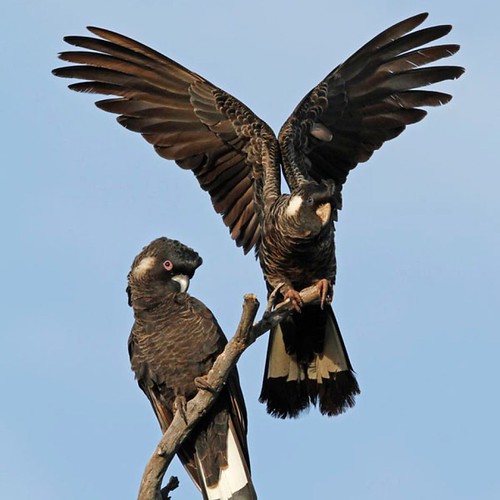 Carnaby's Black Cockatoos perch on a tree branch in WA.The iconic Carnaby's black cockatoo may die out in the Perth region within 15 years, a report has found, prompting calls for the state and federal governments to protect remaining habitats.
Carnaby's Black Cockatoos perch on a tree branch in WA.The iconic Carnaby's black cockatoo may die out in the Perth region within 15 years, a report has found, prompting calls for the state and federal governments to protect remaining habitats.
The 2014 Great Cocky Count report by Birdlife Australia and Western Australia's Department of Parks and Wildlife estimated the current rate of decline in the cockatoos' population on the Perth-Peel coastal plain was 15 per cent per year.
The minimum count for the birds in the region was 7154, with 59 per cent of those found around the Gnangara Pine Plantation, north of Perth.
The figure represents up to 10 per cent of the entire population of the species, which is endemic to Western Australia's South West.
Birdlife Australia said the cockatoos had adapted to the pine plantations in the 1950s to survive the loss of 1,000 hectares of native bush around Perth each year.
Pines 'must be protected' to save species
But the group's head of conservation, Samantha Vine, said 1,000 hectares of pine plantations around the city were also being cleared every year.
She said the State Government's plan to completely clear the 23,000 hectare Gnangara Pine Plantation, to preserve the vital underground water source which lies beneath, would be catastrophic.
Ms Vine called on the Government to stop clearing pine until replacement trees were planted and matured.
Birdlife Australia wants the Gnangara Pine Plantation referred for Commonwealth environmental assessment.
It has also written to the Federal Environment Minister, Greg Hunt, requesting the Government take action to prevent the extinction of the population.
"We've done some really robust analyses and shown they're declining by 15 per cent per year at the moment," Ms Vine said.
"If this continues we're likely to see extinction of the [Perth] population in the next 15 years."
However, the report warned the declining trend should be treated with caution "given the brief time period assessed and the need to assess spatial relationships among roosts".
"Nonetheless, if this decline continues, it is of serious concern for Carnaby's black cockatoos in the Perth-Peel coastal plain," it said.
Urgent action needed: Opposition
State Opposition environment spokesman Chris Tallentire said this was further proof urgent action was needed to save the Carnaby's cockatoos.
"Despite repeated warnings, the Barnett Government has failed to act to protect feeding and roosting areas to save the species from extinction," he said.
WA Environment Minister Albert Jacob said the decline in the number of Carnaby's cockatoos in the Perth metropolitan area was a cause of concern.
 Carnaby's Black Cockatoos nesting in Western Australia."However, a number of factors could be driving this, including drought, car strike and clearing of pines," Mr Jacob said.
Carnaby's Black Cockatoos nesting in Western Australia."However, a number of factors could be driving this, including drought, car strike and clearing of pines," Mr Jacob said.
"This is a highly mobile species, occurring over a large area of the South West, so we don't know whether the birds are utilising other habitat and resources that were not surveyed."
He said the impact of the removal of the Gnangara and other pine plantations on Carnaby's cockatoos was being examined as part of a strategic assessment of the Perth and Peel Regions being conducted under the Commonwealth Environment Protection and Biodiversity Conservation Act.
"We are taking a strategic approach to planning that quantifies the impact of the pine removal on Carnaby's, along with other proposed developments, and identifies a range of offset measures that seek to minimise the impact to Carnaby's cockatoo," Mr Jacobs said.
He said there was a well-established recovery plan for the birds.
A spokesman for Federal Environment Minister Greg Hunt said: "the Commonwealth and state have agreed that the harvesting of pines within the strategic assessment area will be considered as part of this strategic assessment".
Surviving population numbers unclear
The federal Department of Environment website stated it was difficult to know how many Carnaby's black cockatoos were left.
But it said it was known their populations had declined by more than 50 per cent in the past 45 years.
They no longer bred in up to a third of their former breeding sites in WA's Wheatbelt region.
"The cockatoos live for 40-50 years in the wild," the department's website said.
"A large proportion of the remaining population now is past breeding age.
"When these older birds die, there will be very few younger birds to take their place."